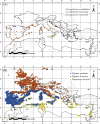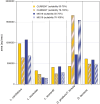Past and current climate as a driver in shaping the distribution of the Longitarsus candidulus species group (Coleoptera: Chrysomelidae)
- PMID: 39367725
- PMCID: PMC11452734
- DOI: 10.1093/jisesa/ieae089
Past and current climate as a driver in shaping the distribution of the Longitarsus candidulus species group (Coleoptera: Chrysomelidae)
Abstract
Longitarsus candidulus (Foudras) is a thermophilic flea beetle species widely distributed in the Mediterranean Basin and associated with Daphne gnidium L. and Thymelaea hirsuta (L.). Longitarsus laureolae Biondi and Longitarsus leonardii Doguet, phylogenetically closely related to L. candidulus, show together a peculiar and rare disjunct distribution along the central-southern Apennines and the Cantabrian-Pyrenean mountain system, respectively. Both are associated with Daphne laureola L. in mesophilic habitats. We used "ecological niche modeling" to infer the Pleistocene dynamics in the distribution of the three flea beetle species and their host plants. We interpreted their current distributions, paying particular attention to the presumed time of species divergence as inferred from recent studies. The differentiation of L. laureolae and L. leonardii from L. candidulus likely represents a response to the marked climatic changes during the Late Pliocene. Such a split was likely associated with a trophic niche shift of the laureolae/leonardii ancestor towards the typically mesophilic host plant D. laureola. The subsequent split between L. laureolae and L. leonardii, possibly due at first to the niche competition, was then boosted by an allopatric divergence during the Middle Pleistocene, likely caused by a large area of low environmental suitability for both species, mainly located between the northern Apennines and the south-western Alps.
Keywords: Alticini; Thymelaeaceae; ecological modeling; marine isotope stage 19.
© The Author(s) 2024. Published by Oxford University Press on behalf of Entomological Society of America.
Figures







Similar articles
-
Apennine-Pyrenees disjunct distribution: an unusual biogeographic pattern revealed in flea beetles of the Longitarsus candidulus species-group (Coleoptera, Chrysomelidae).Curr Zool. 2023 Dec 26;70(5):668-677. doi: 10.1093/cz/zoad050. eCollection 2024 Oct. Curr Zool. 2023. PMID: 39463688 Free PMC article.
-
Pliocene-Pleistocene ecological niche evolution shapes the phylogeography of a Mediterranean plant group.Mol Ecol. 2018 Apr;27(7):1696-1713. doi: 10.1111/mec.14567. Epub 2018 Apr 19. Mol Ecol. 2018. PMID: 29577497
-
Host plant associations in Western Palaearctic Longitarsus flea beetles (Chrysomelidae, Galerucinae, Alticini): a preliminary phylogenetic assessment.Zookeys. 2019 Jun 17;856:101-114. doi: 10.3897/zookeys.856.32430. eCollection 2019. Zookeys. 2019. PMID: 31258369 Free PMC article.
-
Phenological and elevational shifts of plants, animals and fungi under climate change in the European Alps.Biol Rev Camb Philos Soc. 2021 Oct;96(5):1816-1835. doi: 10.1111/brv.12727. Epub 2021 Apr 27. Biol Rev Camb Philos Soc. 2021. PMID: 33908168 Review.
-
Spatial and temporal changes in the abundance and compostion of ladybird (Coleoptera: Coccinellidae) communities.Curr Opin Insect Sci. 2017 Apr;20:61-67. doi: 10.1016/j.cois.2017.04.001. Epub 2017 Apr 10. Curr Opin Insect Sci. 2017. PMID: 28602237 Review.
References
-
- Alfieri A. 1976. The Coleoptera of Egypt. Mémoires de la Société entomologique d’Egypte. 5:1–361.
-
- Allouche O, Tsoar A, Kadmon R.. 2006. Assessing the accuracy of species distribution models: prevalence, kappa and the true skill statistic (TSS). J. Appl. Ecol. 43(6):1223–1232. 10.1111/j.1365-2664.2006.01214.x - DOI
-
- Baselga A, Novoa F.. 2000. Los Chrysomelidae (Coleoptera) de los sistemas dunares de Galicia (Noroeste de España). Boletín de la Real Sociedad Española de Historia Natural (Sec. Biol.). 96(1-2):113–124.
-
- Baselga A, Novoa F.. 2001. Citas nuevas de Chrysomelidae (Coleoptera) de Galicia (Noroeste de la Península Ibérica). Boletín de la Asociación española de Entomología. 25(1-2):125–131.
MeSH terms
LinkOut - more resources
Full Text Sources
Miscellaneous

